The most spectacular economic miracle has been flying under the radar for two decades now, but its impact will be universally acknowledged very soon. This is the story of China. The flip side of that miracle is a coalition of a superpower and former empires, straddled with shrinking middle class, rising debt and dwindling geopolitical hegemony. That is the story of America and Europe. Let’s take a look at the stories and see how they’re intertwined.
Most people still think of China as a “communist,” polluted, poor country that either makes horrible, cheap stuff or assembles expensive products for Western corporations. In terms of GDP per capita, China is ranked 70th in the world, below many Latin American countries. And there are 40 million Chinese who still live on less than $2 a day.
However, 87% of Chinese say their country is going in the right direction (that number is 43% for America). Why? Here is the paradoxical truth: while the average individual may not be rich, China as a nation has transformed itself into a global powerhouse. China’s GDP is now the 2nd largest in the world. In terms of PPP – Purchasing Power Parity – China’s economy is actually bigger than the U.S. This is because $100 in China will get you lot more than $100 in America.
China is also #1 in the world in foreign-exchange reserves – it has more than $3 trillion saved up, which includes $1.2 trillion of US treasury bonds. Can’t be that poor, right?
To visualize the Chinese transformation, look at the picture below that shows how China’s GDP has grown in the last 25 years relative to the US and other top nations. If you had shown this chart to economics experts or ordinary people back in 1992, they would’ve laughed at you!
China’s GDP growth comes not from financial manipulations and casino capitalism, but labor-intensive manufacturing and exports. Rather than cheap t-shirts, China’s top three exports now are computers, TVs and smartphones. The mode of manufacturing is also changing rapidly, with China deploying 400,000 industrial robots in its manufacturing sector this year. Check out China’s growth in total exports over the years, compared to the US:
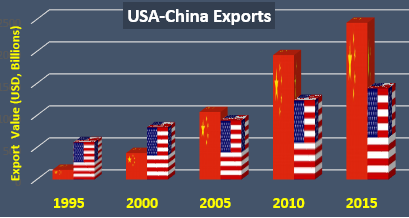 What do the USA, Germany, Japan, South Korea, Saudi Arabia, Iran, Brazil and 125 other countries have in common? Their largest trading partner is China. (Trade is exports + imports.)
What do the USA, Germany, Japan, South Korea, Saudi Arabia, Iran, Brazil and 125 other countries have in common? Their largest trading partner is China. (Trade is exports + imports.)
Here are some stats that further demonstrate China’s global dominance: #1 in world trade, #1 exporter, #2 importer, #1 manufacturer, and #2 in market capitalization of stock market ($7 trillion).
Infrastructure
China has become the king of infrastructure as well. Between 2011 and 2013, China used more cement than America did in entire 20th century! It now has 12 out of top 25 tallest buildings (US has 4) and 6 out of top 10 longest bridges. In the last four years, China built 264 skyscrapers (USA built 20). To link all the major industrial regions of China, there are 14,000 miles of high-speed railway lines where the fastest trains in the world fly by at 220 mph. There are even maglev – magnetically levitated – trains, which are being updated to reach a stupendous speed of 600 Km/hr by 2020.
China has become an absolute powerhouse in green energy, partially because of the pollution problems it faces. It’s now #1 in manufacturing of solar panels (producing 2/3rd of solar panels in the world) as well as total solar power output. In 2017, China added five times as much solar power as the US (53 GW to 10 GW). China is also #1 in wind energy, installing on the average one new wind turbine every hour. It’s #1 in the production of electric cars, churning out three times as many e-cars as the US in 2017. In Shenzhen, China, all buses are electric, and there are 16,000 of them! There are even hydrogen-powered trams whose only emission is water!
From assembling iPhones for $1 an hour, China has become a global leader in smartphones. Four Chinese companies – Huawei, Oppo, Xiaomi and Vivo – combined have twice the global market share as Apple. Chinese smartphones are popular in Asia and Europe – Xiaomi is already the #1 smartphone in India – and it’s only a matter of time before they show up in the US market.
China has the most number of supercomputers as well as the most powerful supercomputer on Earth. It has also established firm leadership in the breakthrough technology of quantum computing and quantum satellites.
Chinese hi-tech startups are also proving their mettle in innovation and are making staggering advancements in areas such as artificial intelligence, self-driving/smart cars, face-recognition technology, robotics, etc. There are now 98 “unicorns” in China – startups that are valued at $1 billion or more. China’s venture capital fundraising is now almost as big as the US. Chinese VC firms are going global, investing in startups in India and other Asian countries.
 China has become the world leader in e-commerce and mobile payments. In big cities, cash and credit cards are becoming obsolete. In 2017, Chinese used smartphone apps such as WeChat or AliPay for $9 trillion worth of financial transactions, as compared with just over $100 billion in the US. Thus it’s no wonder that Chinese tech firms Alibaba and Tencent have made it to the list of Top 10 global corporations (ranked by market cap).
China has become the world leader in e-commerce and mobile payments. In big cities, cash and credit cards are becoming obsolete. In 2017, Chinese used smartphone apps such as WeChat or AliPay for $9 trillion worth of financial transactions, as compared with just over $100 billion in the US. Thus it’s no wonder that Chinese tech firms Alibaba and Tencent have made it to the list of Top 10 global corporations (ranked by market cap).
Investments and Acquisitions
China has eagerly embraced acquisitions and corporate investments. Last year alone, it invested about $250 billion in the U.S. In a reversal of roles, China is even building manufacturing plants in the US and employing Americans. For example, GM had closed a manufacturing plant in Ohio in 2008. A Chinese company reopened it and now employs 2,000 people! In California, a Chinese company – BYD – has a factory to build 1,500 electric buses every year. There are now more than 140,000 Americans who are employed by China-affiliated/owned companies.
In the last few years, China has bought many valuable brand names such as Volvo, Motorola, GE appliances, Lenovo, Hoover US, Waldorf Astoria, Radisson Hotels, Club Med, Syngenta, Smithfield Foods, AMC Theaters, etc. In Europe, Chinese companies have bought soccer clubs, retail stores, luxury clothing brands, pharmacy chains, hotels, robotics companies and more. In Australia, they have bought many mines, huge farms and wineries. As for Africa, its largest trading partner is now China.
In the Middle East and Latin America, China has a lot of clout since it’s the world’s largest importer of oil and other commodities.
How did they do it?
The quick answer that many people give is China copies everything. If it were that easy, then many other countries would have done that. In 1981, more than 88% of Chinese lived under $2/day. It’s almost impossible for a poor country to get out of the poverty trap, but China did it. Today, China has the largest middle class in the world, more than 300 billionaires, and 2 million millionaire households. As for extreme poverty, it has now been reduced to 4%.
It may come as a surprise to many that China had one of the highest GDP in the world for many centuries. For 1800 years, India and China were the dominant countries in the world. They became poor only when the British colonized India and then brought China down using opium. In China, the period between 1840 and 1940 is called the Century of Humiliation.
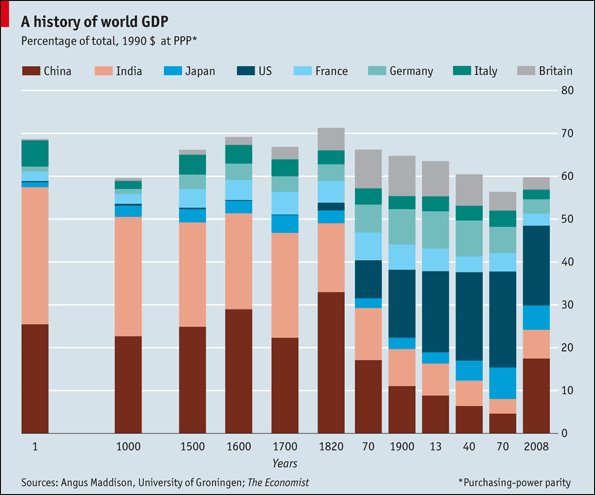 To make China great again, Chinese leaders and the people understood they had to start small. Thus they first made deals with the West to manufacture low-end products. Then they offered 50-50 partnership for Western corporations to open manufacturing plants for cars and computers. This meant Chinese workers could become engineers, managers and accountants rather than just factory laborers in an assembly line.
To make China great again, Chinese leaders and the people understood they had to start small. Thus they first made deals with the West to manufacture low-end products. Then they offered 50-50 partnership for Western corporations to open manufacturing plants for cars and computers. This meant Chinese workers could become engineers, managers and accountants rather than just factory laborers in an assembly line.
China also protected its media and the political system. Rather than just taking the lazy route and using Facebook, Twitter, Google, PayPal, eBay, Hollywood shows, etc., they developed their own versions, even if they were copycats. This gave way to technology giants such as Alibaba, Baidu, Tencent, Weibo, Huawei, etc. The strategic and economic importance of these actions cannot be exaggerated.
China as a country also saved money, because they understood that capital is the most powerful tool in capitalism. And they pooled their savings into investments – infrastructure, more factories, and employing smart minds from the West.
While Americans were told to consume, consume and consume … Chinese were told to invest, invest, invest.
In the last twenty years, China exported $5 trillion worth of goods to America, while importing only $1 trillion. They worked hard to produce tangible goods, and we sent them IOUs. The result is seen in the picture below:
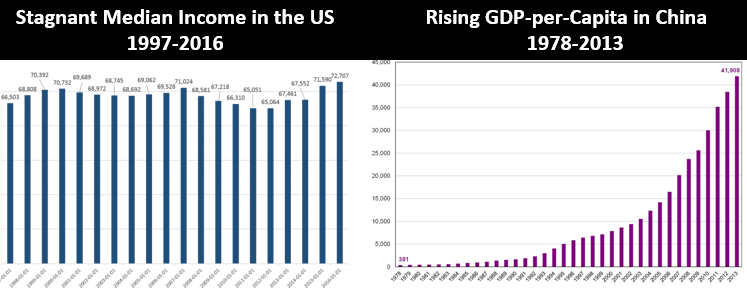 That the Chinese government has authoritarian power over people in many areas also contributed to this growth. For example, if the government decides that 10 million people from rural areas should move to certain cities, it will be accomplished. Similarly, policies on how many children one can have is unreasonable, but has helped China control the population. Many other decisions are also made quickly without extensive public debates and dramas, which cause political inefficiency or paralysis in more democratic nations.
That the Chinese government has authoritarian power over people in many areas also contributed to this growth. For example, if the government decides that 10 million people from rural areas should move to certain cities, it will be accomplished. Similarly, policies on how many children one can have is unreasonable, but has helped China control the population. Many other decisions are also made quickly without extensive public debates and dramas, which cause political inefficiency or paralysis in more democratic nations.
In China, the government and corporations are also strongly interlinked. This means that the government can set specific goals for corporations as well as provide massive subsidies and bailouts. Strange as it seems to us, this has worked in China, in spite of the many potential problems with such a hybrid system. They call it a “socialist system with Chinese characteristics.”
Avoiding Thucydides Trap
To avoid conflicts with established world powers, China shared its profits with Western oligarchs and corporations. These Western elites, driven by short-term thinking and greed, quickly outsourced as many American and European jobs as possible. For the bean counters in the West, a Chinese worker who works for $10/hr is obviously a better choice than an American who demands $40/hr. For an American investment bank which facilitates mergers and acquisitions, it makes no difference if a Chinese company buys an American company or vice versa – it’s only about commission.
China has also played geopolitics extremely well. In fact, Chinese experts traveled all over the world in the 1990s and met with experts on a wide range range of topics, including military, history and geopolitics. Perhaps the most important concept they learned was how a rising new power always ended up in wars against the the status quo powers – Germany and Japan being two salient examples of the last century. This is also called the Thucydides Trap, and the Chinese were determined to avoid it.
Thus China, unlike Putin, never challenged America’s military-industrial-media complex. Playing defensive, it befriended key strategic Asian countries. Through the creation of alliances such as BRICS (Brazil, Russia, India, China, South Africa) and SCO, China has secured many allies around the world. China-led financial institutions as AIIB (Asian Infrastructure Investment Bank), New Development Bank and China’s Export-Import bank have become the go-to lenders for many countries.
Make Trade, Not War
The US wasted trillions of dollars on wars since 2000 and made plenty of enemies. While the US bombed Libya, an African country, China is lending $45 billion of its own money and expertise to build a new capital for Egypt, Libya’s neighbor. Throughout Africa, China has adopted a win-win approach. While buying natural resources from Africa, China has also spent a lot of money building Africa’s infrastructure. A recent McKinsey report shows that there are over 10,000 Chinese companies in Africa, creating millions of good jobs for Africans. Compare that to the US, which builds military bases all over Africa.
 China has developed strong trade relationships to EU, becoming the #1 exporter to EU. Every day a few freight trains leave China with millions of dollars of goods to be delivered to 15 different major European cities. It takes only 2.5 weeks to travel 8000 miles and deliver the goods to London after passing through Kazakhstan, Russia, Belarus, Poland, Germany, Belgium and France!
China has developed strong trade relationships to EU, becoming the #1 exporter to EU. Every day a few freight trains leave China with millions of dollars of goods to be delivered to 15 different major European cities. It takes only 2.5 weeks to travel 8000 miles and deliver the goods to London after passing through Kazakhstan, Russia, Belarus, Poland, Germany, Belgium and France!
Beyond selling goods, China is also involved in various projects all over Europe – building a nuclear power plant in the UK, joint venture with a French car company to build electric SUVs, construction of an industrial park in Serbia, funding a massive healthcare center in Spain that would combine Chinese and western medicine, partnering with Poland to launch a satellite, and the list goes on and on.
Culture and Social Values
While analyzing China’s success, the cultural aspect certainly cannot be ignored. Hard work, discipline, sacrifice, moderation, shared values, focus on education, saving money, and investing for the future are all deeply ingrained in the Asian/Chinese culture.
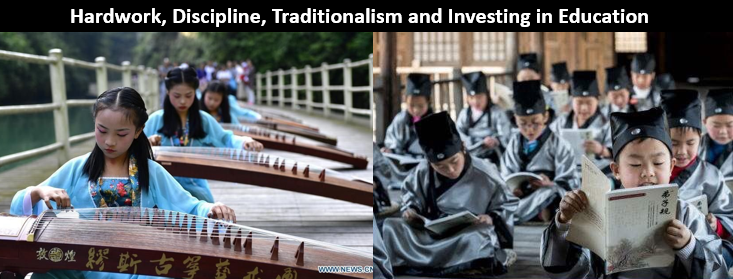 Although there’s widespread corruption in many areas, China’s top leaders have a patriotic vision of greatness of their country. They translate this vision into comprehensive plans for the next 5, 10, 20 and 30 years. As for President Xi Jinping, he describes this vision as the “rejuvenation of China” and the “China Dream” for the “New Era.” In the 1990s, Chinese elites could have simply enriched themselves by turning the country into a giant pool of cheap laborers for the West. Instead, China’s leaders took the harder, challenging route and have accomplished the impossible.
Although there’s widespread corruption in many areas, China’s top leaders have a patriotic vision of greatness of their country. They translate this vision into comprehensive plans for the next 5, 10, 20 and 30 years. As for President Xi Jinping, he describes this vision as the “rejuvenation of China” and the “China Dream” for the “New Era.” In the 1990s, Chinese elites could have simply enriched themselves by turning the country into a giant pool of cheap laborers for the West. Instead, China’s leaders took the harder, challenging route and have accomplished the impossible.
The Future
Geopolitical experts in the 1990s never expected China to become a global player. Now, China is recreating its Silk Road from 2500 years ago. Only this time, it’s called Belt and Road Initiative (or, One Belt, One Road) and involves China spending $1 trillion in 67 other countries to build all kinds of infrastructure – highways, railways, sea ports, airports, pipelines, power plants, solar farms, dams and so on.
 The most important phenomenon to observe is the rise of Yuan – China’s currency. China has already made deals with Russia, Iran and Qatar to trade in local currencies. If Saudi Arabia, whose biggest customer is China, decides to bypass the US dollar and sell oil in Yuan, others will follow and it will be the beginning of the end of dollar hegemony.
The most important phenomenon to observe is the rise of Yuan – China’s currency. China has already made deals with Russia, Iran and Qatar to trade in local currencies. If Saudi Arabia, whose biggest customer is China, decides to bypass the US dollar and sell oil in Yuan, others will follow and it will be the beginning of the end of dollar hegemony.
By 2030, China is projected to overtake the U.S. in nominal GDP. China still lags behind the U.S. in military, several key technologies, soft power and in the general concept of innovation. However, one would be greatly mistaken to assume that the advantage would last for long. The 21st century might very well be defined by the ascendant Chinese dream.
Chris Kanthan is the author of a new book, Syria – War of Deception. It’s available in a condensed as well as a longer version. Chris lives in the San Francisco Bay Area, has traveled to 35 countries, and writes about world affairs, politics, economy and health. His other book is Deconstructing Monsanto.

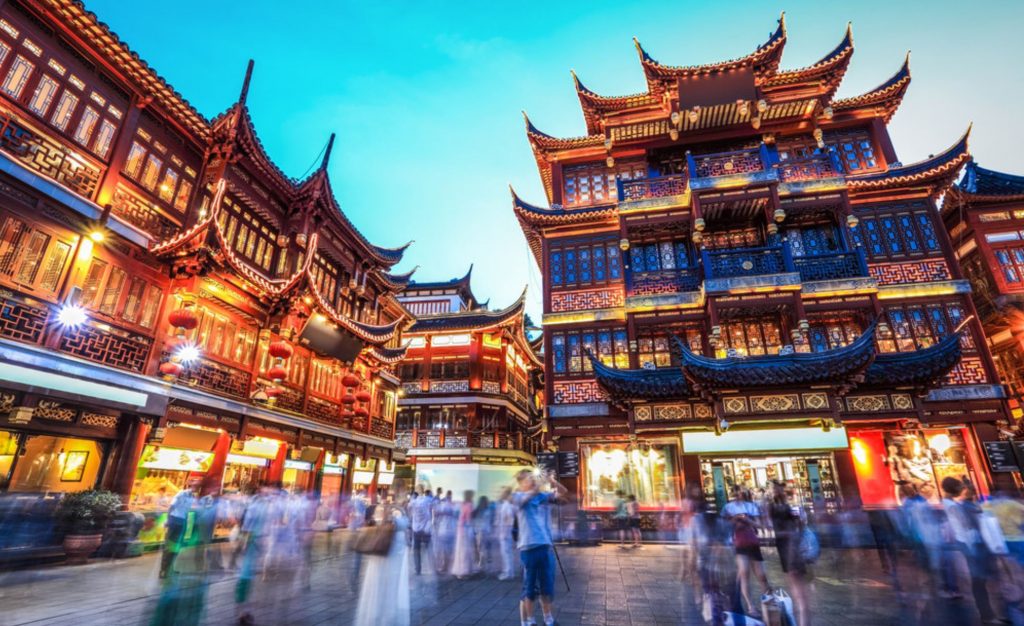

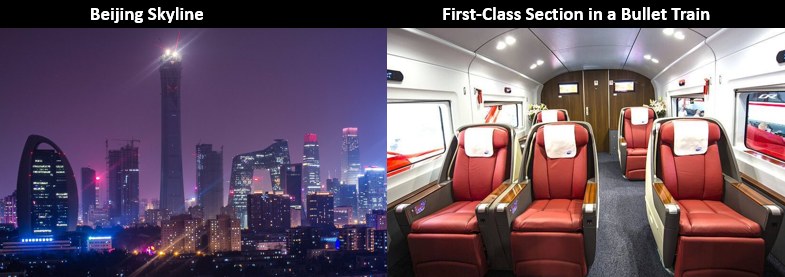

So they should be able to function just fine without the American consumer or industry. Let’s cut them off and raise the tariffs.